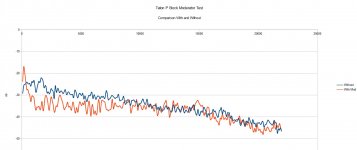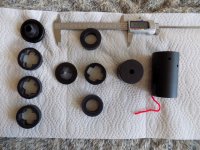I posted yesterday regarding my Talon P and got a question about the moderator.
Also posted about the rifle here earlier this month.
I ran the test on it today.
The video is plagued with wind noise and not really worth watching. The question was how well does it work?
I shot three shots with the moderator on the gun and then three without it. Here is the audio comparison.
Here is that audio slowed down to 1/8 speed and cropped to only the muzzle blast for each shot.
Here is the comparison graph of the signatures.

The RMS power for the moderated gun was 2.2 dBs less than the RMS power level for the unmoderated gun. That may not sound like much but your ears are telling you otherwise, aren't they?
That 2.2 dBs represents a TRUE 40% reduction in the total noise output from the moderator. That is quite good. Add to that the fact the signature (on the graph you can see it) is substantially shifted to the lower end of the spectrum. The net result is quite pleasant to the ear.
This is a very good moderator.
It is about 52mm by 91mm. It is very light. This image shows the moderator disassembled and laid out as it was disassembled top to bottom left to right.

The unit contains starting from top left moving in columns.
I like it.
Also posted about the rifle here earlier this month.
I ran the test on it today.
The video is plagued with wind noise and not really worth watching. The question was how well does it work?
I shot three shots with the moderator on the gun and then three without it. Here is the audio comparison.
Here is that audio slowed down to 1/8 speed and cropped to only the muzzle blast for each shot.
Here is the comparison graph of the signatures.

The RMS power for the moderated gun was 2.2 dBs less than the RMS power level for the unmoderated gun. That may not sound like much but your ears are telling you otherwise, aren't they?
That 2.2 dBs represents a TRUE 40% reduction in the total noise output from the moderator. That is quite good. Add to that the fact the signature (on the graph you can see it) is substantially shifted to the lower end of the spectrum. The net result is quite pleasant to the ear.
This is a very good moderator.
It is about 52mm by 91mm. It is very light. This image shows the moderator disassembled and laid out as it was disassembled top to bottom left to right.

The unit contains starting from top left moving in columns.
- attachment adapter
- clover shaped foam baffles (3)
- solid washer with a 8.2mm bore hole
- circular foam baffle
- another clover shaped foam baffle
- circular foam baffle
- endcap in the form of a cup with a 9.3mm bore hole
- moderator body
I like it.
Last edited: